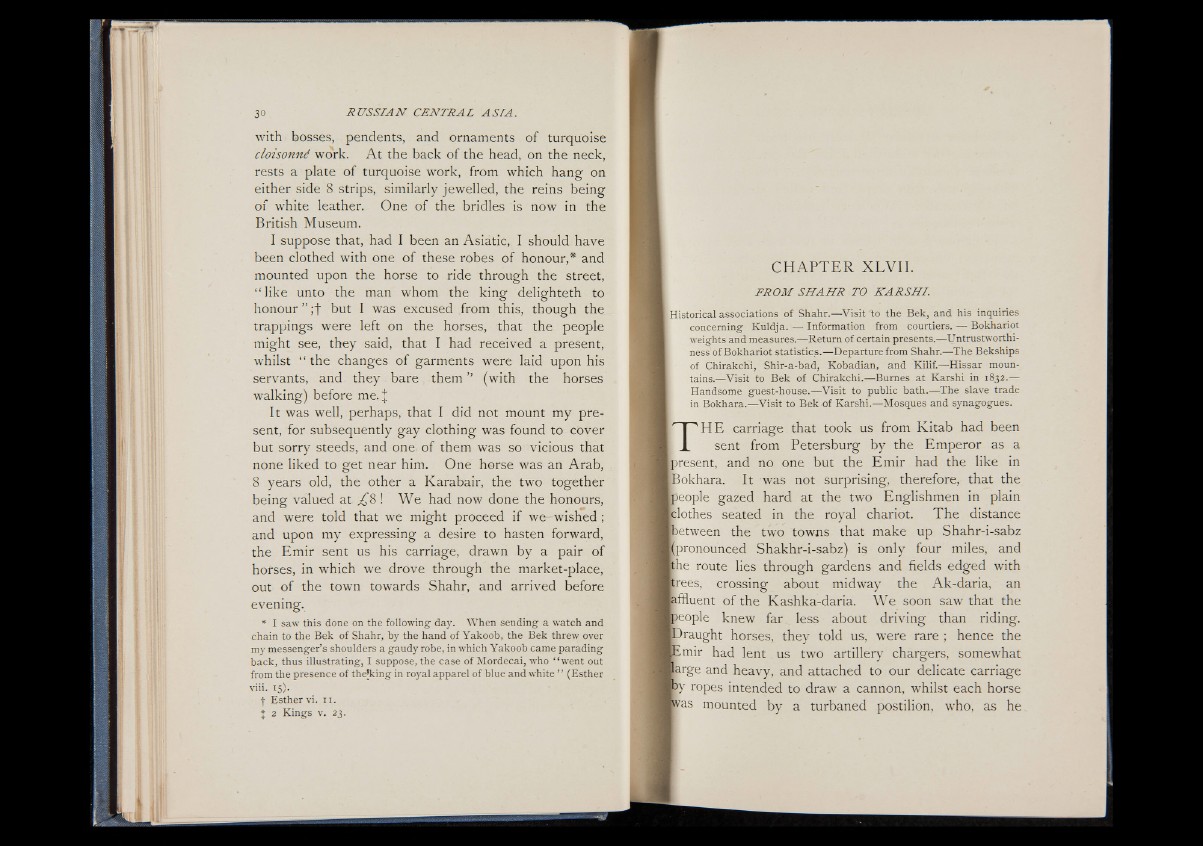
with bosses, pendents, and ornaments of turquoise
cloisonné work. A t the back of the head, on the neck,
rests a plate of turquoise work, from which hang on
either side 8 strips, similarly jewelled, the reins being
of white leather. One of the bridles is now in the
British Museum.
I suppose that, had I been an Asiatic, I should have
been clothed with one of these robes of honour,* and
mounted upon the horse to ride through the street,
“ like unto the man whom the king delighteth to
honour ” ;t but I was excused from this, though the
trappings were left on the horses, that the people
might see, they said, that I had received a present,
whilst “ the changes of garments were laid upon his
servants, and they bare them ” (with the horses
walking) before me.J
It was well, perhaps, that I did not mount my present,
for subsequently gay clothing was found to cover
but sorry steeds, and one of them was so vicious that
none liked to get near him. One horse was an Arab,
8 years old, the other a Karabair, the two together
being valued at £%\ We had now done the honours,
and were told that we might proceed if we wished ;
and upon my expressing a desire to hasten forward,
the Emir sent us his carriage, drawn by a pair of
horses, in which we drove through the market-place,
out of the town towards Shahr, and arrived before
evening.
* I saw this done on the following day. When sending a watch and
chain to the Bek of Shahr, by the hand of Yakoob, the Bek threw over
my messenger’s shoulders a gaudy robe, in which Yakoob came parading
back, thus illustrating, I suppose, the case of Mordecai, who “ went out
from the presence of thejking in royal apparel of blue and white ’ ’ (Esther
viii. 1 0
j- Esther vi. i i .
+ 2 Kings v. 23.
C H A P T E R X L V I I .
FROM SHAHR TO K A R SH I .
¡Historical associations of Shahr.—Visit to the Bek, and his inquiries
concerning Kuldja. — Information from courtiersJli^Bokhariot
weights and measures.BRetum of certain presents.— Untrustworthi-
ness'of Bokhariot statistics.—Departure from Shahr.— The Bekships
of Chirakchi, Shir-a-bad, Kobadian, and Kilif.—Hissar mountains.—
Visit to Bek of Chirakchi.— Bumes at Karshi in 1832.—
Handsome guest-house.—Visit to public bath.—The slave trade
in Bokhara.—Visit to Bek of Karshi.—Mosques and synagogues.
TH E carriage that took us from Kitab had been
sent from Petersburg by the Emperor as a
■present, and no one but the Emir had the like in
■Bokhara. It was not surprising, therefore, that the
■people gazed hard at the two Englishmen in plain
■clothes seated in the royal chariot. T h e distance
■between the two towns that make up Shahr-i-sabz
(pronounced Shakhr-i-sabz) is only four miles, and
|he route lies through gardens and fields edged with
trees, crossing about midway the Ak-daria, an
[affluent of the Kashka-daria. W e soon saw that the
[people knew far less about driving than riding.
■Draught horses, they told us, were rare ; hence the
jEmir had lent us two artillery chargers, somewhat
Barge and heavy, and attached to our delicate carriage
lay ropes intended to draw a cannon, whilst each horse
■vas mounted by a turbaned postilion, who, as he